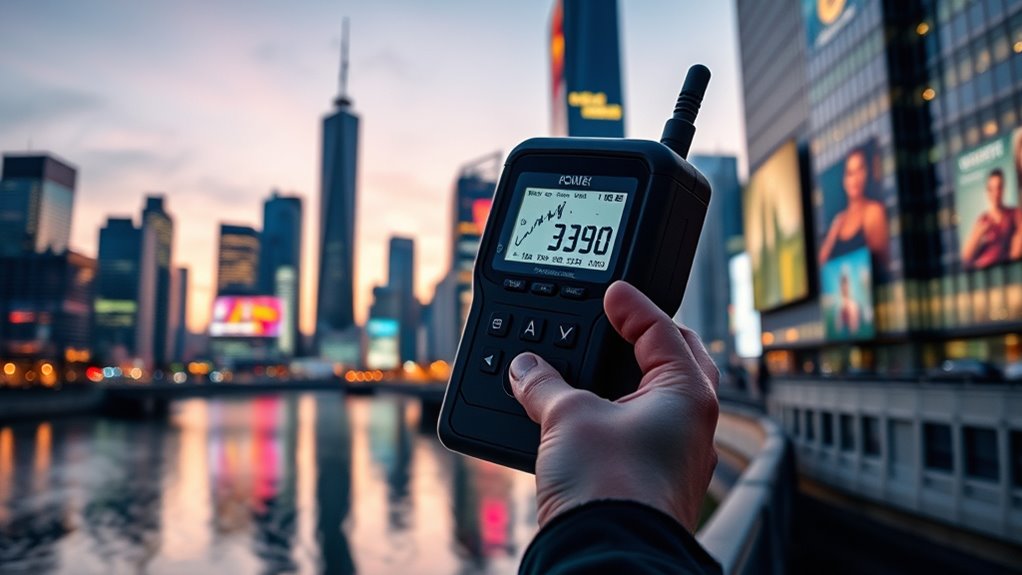EMF exposure comes from everyday devices like phones, Wi-Fi, and TVs, but scientific evidence shows that low-level, non-ionizing radiation is generally safe within established guidelines. Regulatory agencies set safety standards to protect you, and practical steps like limiting device use and avoiding wireless chargers help reduce exposure. By understanding the difference between facts and fears, you can make informed choices. Keep exploring to learn more about how to stay safe while staying connected.
Key Takeaways
- Most everyday EMF exposures are from non-ionizing radiation, which is generally considered safe within established safety standards.
- Regulatory agencies set safety limits based on scientific reviews to protect public health from potential EMF risks.
- Scientific studies show mixed results; current evidence does not conclusively link typical EMF exposure to serious health issues.
- Practical measures like distancing devices, turning off unused wireless equipment, and using wired connections can reduce EMF exposure.
- Rely on reputable sources and scientific consensus to distinguish facts from fears and avoid misinformation about EMF health risks.
Understanding What Electromagnetic Fields Are

Electromagnetic fields (EMFs) are invisible areas of energy that surround electronic devices and electrical systems. These fields are part of the electromagnetic spectrum, which includes a range of wave types from very low frequencies to high-energy rays. When electrical devices operate, they generate these fields through field interactions with nearby objects and living tissues. Understanding EMFs means recognizing how they behave and their properties. The strength of an electromagnetic field depends on factors like the power source and distance from the device. While EMFs are invisible, their presence influences how electronic devices function and can interact with biological systems. Knowing how these fields work helps you differentiate between harmless exposure and situations that might warrant cautious consideration. Additionally, ongoing research into data privacy challenges emphasizes the importance of understanding electromagnetic interference and its potential impact on electronic security and device performance.
Common Sources of EMF in Daily Life

You encounter EMF from household electronics like TVs, microwaves, and laptops every day. Wireless devices such as smartphones, tablets, and Wi-Fi routers also emit EMF signals constantly. Understanding these common sources helps you manage your exposure in daily life. Additionally, some electronic devices may have hidden vulnerabilities that could potentially be exploited through techniques similar to those used in ethical hacking.
Household Electronics and Devices
Many household electronics and devices emit electromagnetic fields during regular use, making them common sources of EMF exposure in daily life. For example, wireless charging pads emit low-level EMFs when powering your devices. Smart home systems, which connect appliances and security devices via Wi-Fi or Bluetooth, also produce EMFs during operation. You might not notice these fields, but they’re present whenever you’re using or near such devices. Laptops, tablets, and cordless phones are additional sources that contribute to your daily EMF exposure. While these devices are convenient, understanding their EMF emissions helps you make informed choices about their placement and usage. Reducing unnecessary exposure is simple—keep devices at a distance when possible and limit prolonged close contact. Being aware of electromagnetic field emissions from everyday electronics allows for better management of your environment and potential health considerations.
Wireless Communication Technologies
Wireless communication technologies are among the most common sources of EMF exposure in everyday life. You’re constantly exposed to wireless signals from devices like smartphones, tablets, Wi-Fi routers, and cell towers. These signals emit low levels of electromagnetic fields that travel through the air and penetrate your surroundings. Device emissions vary depending on the technology and distance; for example, your smartphone emits more EMF when actively transmitting data. While these signals are essential for modern communication, concerns about their health effects persist. However, the EMF levels from wireless devices are generally well below safety limits set by health authorities. Being aware of how wireless signals and device emissions operate helps you make informed decisions about your exposure, without unnecessary fear. Additionally, understanding the contrast ratio of projectors can help optimize your viewing environment, although it is unrelated to EMF exposure.
Scientific Evidence on EMF and Health Risks

Scientific studies investigating the health risks of electromagnetic field (EMF) exposure have produced mixed results, making it difficult to draw definitive conclusions. The electromagnetic spectrum encompasses a wide range of radiation, from low-frequency radio waves to high-energy X-rays. Most research focuses on non-ionizing radiation, which is generally considered less harmful. While some studies suggest potential links between prolonged EMF exposure and certain health issues, the overall evidence remains inconclusive. Regulatory agencies worldwide have reviewed these findings and set safety guidelines to limit exposure. It’s important to understand that radiation health concerns depend on frequency, intensity, and duration of exposure. Additionally, ongoing research into AI’s role in safety assessments highlights the importance of continued scientific investigation into EMF health effects. Currently, the scientific community continues to study EMF effects, emphasizing the need for ongoing research to better understand any potential risks.
Distinguishing Between Ionizing and Non-Ionizing Radiation

Electromagnetic radiation covers a broad spectrum, with varying effects depending on its energy level. To understand EMF exposure, it’s essential to distinguish between ionizing and non-ionizing radiation. Ionizing radiation, like X-rays and gamma rays, has enough energy to remove electrons from atoms, potentially causing cellular damage. Non-ionizing radiation, including radio waves and visible light, lacks this power and is generally safer at typical exposure levels. In radiation safety, exposure limits are set to prevent harm, especially from ionizing sources. Recognizing the differences helps you assess risks accurately. While non-ionizing EMFs are generally considered safe within established limits, ionizing radiation requires more caution. Knowing this distinction empowers you to interpret EMF exposure more effectively and avoid unnecessary fears. Additionally, understanding the unique properties of different types of radiation can help you make informed decisions about safe levels of exposure.
The Role of Regulatory Agencies and Safety Standards

Regulatory agencies set safety standards to protect you from potential EMF risks, ensuring devices and environments are safe. They establish clear guidelines that manufacturers must follow to keep exposure within safe limits. Compliance with these standards is closely monitored to prevent violations and safeguard public health. Regular testing and updated regulations help adapt safety measures to new scientific findings and technological advances, including beginners guides on EMF exposure.
Regulatory Frameworks and Guidelines
You are trained on data up to October 2023. Regulatory agencies such as the Federal Communications Commission (FCC) and the International Commission on Non-Ionizing Radiation Protection (ICNIRP) establish safety standards and guidelines to limit EMF exposure. These standards are based on extensive scientific research and aim to protect public health by setting maximum permissible exposure levels. Additionally, ongoing research and technological advancements continually inform updates to these safety frameworks, ensuring they remain effective. Regular monitoring and compliance checks help maintain adherence to these regulations, fostering a safer environment for all. Recognizing the importance of regulatory frameworks can help consumers and professionals make informed decisions regarding EMF exposure.
Standards Enforcement and Compliance
Regulatory agencies play a vital role in verifying that safety standards for electromagnetic field (EMF) exposure are actively followed and effectively enforced. They conduct inspections and monitor compliance, ensuring devices like those used in electromagnetic therapy meet safety limits. If a product or practice, such as emf shielding, exceeds accepted exposure levels, agencies can issue recalls or penalties. You should be aware that these agencies also set guidelines to protect the public, making sure manufacturers incorporate safety features in their products. When engaging with EMF-related technologies, it’s essential to verify that proper standards are in place and enforced. This oversight helps prevent unnecessary health risks and ensures that innovations in electromagnetic therapy remain safe and beneficial for users. Additionally, understanding compliance requirements can help consumers make informed decisions about EMF products.
Misconceptions and Myths Surrounding EMF Exposure

Many misconceptions and myths about EMF exposure circulate, often fueled by misinformation and fear. It’s important to do some myth busting to separate fact from fiction. One common fear factor is that everyday devices like cell phones and Wi-Fi cause serious health problems, but scientific evidence doesn’t support these claims at typical exposure levels. Some believe that any EMF exposure is dangerous, yet the reality is that low-level EMFs are non-ionizing and not proven to harm health. Misinformation can amplify fears, leading to unnecessary worry. By understanding the facts, you can avoid falling for myths that exaggerate risks. Remember, most concerns stem from misunderstandings rather than scientific evidence, making myth busting essential to navigate the real versus perceived dangers of EMF exposure. Additionally, knowing about sound recording techniques can help clarify that not all perceived threats are based on scientific data, reinforcing the importance of evidence-based understanding.
Practical Tips for Reducing EMF Exposure

While most concerns about EMF exposure are based on myths, taking practical steps can help you minimize your daily contact with electromagnetic fields. Avoid leaving your wireless chargers plugged in when not in use, as they emit EMF even without charging a device. Keep devices like smartphones and tablets away from your body whenever possible, especially during sleep. Using emf shielding products, such as shielding fabrics or cases, can create a barrier against electromagnetic radiation. Limit your time near high-EMF sources, like Wi-Fi routers, and turn them off when not needed. Reorganize your living space to reduce proximity to EMF sources, and opt for wired connections over wireless whenever possible. Small changes can considerably lower your overall EMF exposure.
How to Stay Informed With Reliable Information

How can you guarantee you’re getting accurate and up-to-date information about EMF exposure? Start by consulting reputable sources like scientific journals, government health agencies, and expert organizations. Be cautious of sensational claims and always verify the evidence behind them. Staying informed involves understanding electromagnetic therapy, which uses controlled EMF exposure for health benefits, and recognizing effective emf shielding techniques to reduce unnecessary exposure. Look for balanced perspectives that consider both potential risks and benefits. Subscribe to trusted newsletters or follow experts who provide evidence-based insights. Avoid misinformation by cross-referencing multiple sources. This approach helps you make informed decisions, ensuring you’re not swayed by fear but guided by reliable, current knowledge.
The Importance of Balanced Risk Assessment

You need to understand how evaluating scientific evidence, communicating risks effectively, and balancing policies all influence EMF safety standards. When assessments are biased or unclear, it becomes harder to make informed decisions. Ensuring these elements are balanced helps protect public health without causing unnecessary alarm.
Scientific Evidence Evaluation
Evaluating the scientific evidence on EMF exposure requires a balanced approach that considers all credible research findings. Understanding the historical context helps you see how perceptions and studies have evolved over time, shaping current standards. It’s essential to recognize ethical considerations, like transparency and integrity, guiding responsible research and policy decisions. By weighing diverse studies, you avoid cherry-picking data that support fears or dismiss legitimate concerns. A thorough assessment involves scrutinizing methodology, sample size, and reproducibility. When you approach EMF research with objectivity, you’re better equipped to distinguish between scientifically supported facts and misconceptions. This balanced view fosters informed decisions, reducing unwarranted fears while maintaining vigilance for genuine health risks.
Risk Communication Challenges
Communicating the risks associated with EMF exposure presents unique challenges because scientific findings often vary in interpretation and significance. Your public perception is easily influenced by media reports, which can amplify fears or downplay dangers. To guarantee balanced risk assessment, it’s crucial to address misconceptions and provide clear, factual information.
- Media influence can distort the true level of risk, creating unnecessary alarm
- Public perception often lags behind scientific consensus, fueling confusion
- Effective communication requires transparency and consistency in messaging
- Engaging trusted sources helps build credibility and calm fears
Policy and Regulation Balance
Why is it crucial to strike a balance in policy and regulation when addressing EMF exposure? Because overregulation can hinder technological progress, while underregulation may leave the public vulnerable. Effective policies should reflect a balanced risk assessment, considering scientific evidence without fueling unnecessary fears. Clear policy implications help guide safe deployment of wireless infrastructure and protect public health. At the same time, public education is key to ensuring people understand real risks versus perceived threats. When regulation is too strict or too lax, it can distort public perception and trust. Striking this balance ensures policies are practical, evidence-based, and transparent. Ultimately, a thoughtful approach helps foster innovation while maintaining public confidence and safety.
Future Research Directions and Emerging Technologies

As technology continues to evolve, future research must focus on understanding the long-term effects of EMF exposure and developing safer standards. Exploring quantum effects could reveal how EMFs interact at a subatomic level, influencing biological mechanisms in unforeseen ways. Investigating these interactions will help clarify potential health risks and inform regulations. Emerging technologies, like advanced sensors and modeling tools, will enable precise measurement of EMF exposure and its biological impact. You should also consider the development of biologically inspired shielding materials to minimize exposure. Additionally, studying the cumulative effects of different frequencies and intensities will provide a broad understanding of EMF safety. Staying ahead means integrating cutting-edge physics with biological research to ensure public health protection.
Frequently Asked Questions
Are Children More Vulnerable to EMF Exposure Than Adults?
You might wonder if children are more vulnerable to EMF exposure than adults. Due to their ongoing development, children have higher susceptibility and developmental vulnerability, making them potentially more affected by EMFs. Their smaller size and developing tissues could absorb more radiation. While research is ongoing, it’s wise to minimize children’s exposure, as their vulnerability suggests they could be more impacted than adults by EMF-related risks.
Can EMF Exposure Cause Immediate Health Symptoms?
Think of EMF exposure like a sudden gust of wind. While some people report acute symptoms like headaches, dizziness, or tingling, scientific studies haven’t confirmed consistent immediate effects. You might feel these sensations, but they don’t necessarily mean harm. Most research suggests that, under normal exposure levels, EMFs don’t cause immediate health symptoms. Stay informed, and remember that fear often blows things out of proportion.
How Does EMF Exposure Differ Between Urban and Rural Environments?
You’ll notice that emf density is generally higher in urban environments due to increased wireless devices and infrastructure. In contrast, rural areas typically have lower emf levels because of fewer sources. The urban-rural contrast means your exposure varies, often being greater in cities. However, despite these differences, current evidence suggests that typical exposure levels in both settings are usually safe, but it’s good to stay informed.
Do Certain Electronic Devices Emit Higher EMF Levels Than Others?
You might wonder if some electronic devices emit higher EMF levels than others. Device emission varies markedly depending on the device’s purpose and design. For example, cell phones and Wi-Fi routers generally have higher emissions compared to low-power devices like Bluetooth headsets. When doing a device comparison, consider the emission levels listed by manufacturers or measured by EMF meters to assess potential exposure. Always prioritize devices with lower emission levels for safer use.
What Are the Long-Term Health Effects of Low-Level EMF Exposure?
Imagine sitting near your phone daily, unaware of the subtle biological impacts. Research suggests low-level EMF exposure might contribute to chronic symptoms like headaches or fatigue over time. While definitive long-term effects remain uncertain, it’s wise to limit unnecessary exposure. You can reduce potential risks by maintaining distance from devices and turning them off when not in use. Staying informed helps you make safer choices for your overall health.
Conclusion
As you navigate the modern world, remember that understanding EMFs is like deciphering a medieval map—complex but manageable. Stay informed with trusted sources, avoid unnecessary fears, and take practical steps to reduce exposure. Think of it as steering your ship through foggy waters—cautiously but confidently. By balancing facts with caution, you can embrace technology without losing sight of your well-being, just like a wise sailor steering clear of hidden reefs.









